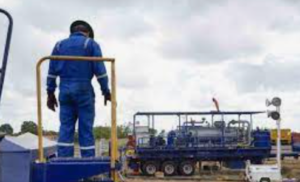A silent revolution is unfolding in America’s oilfields. The same shale producers who drove the U.S. energy renaissance are now racing to meet the demands of a very different frontier: artificial intelligence (AI) data centers.
As AI accelerates, data center electricity demand is projected to skyrocket – potentially consuming 9% of all U.S. electricity by 2030, up from just 2% today. These power-hungry facilities need one thing above all else: 24/7 reliable energy. That’s where shale gas comes in – particularly in the form of behind-the-meter (BTM) generation, which provides power directly to data centers without relying on the public grid.
Across the shale patch, operators are pivoting toward this high-margin, high-growth opportunity. Here’s how leading U.S. oil and gas producers are positioning themselves to fuel the AI era.
Oil & Gas US Operator Account Directory – $10
Includes: Account Name, Location, Phone, Website, Wells Drilled….
ExxonMobil: Going Big on Power with a 1.5 GW Project
ExxonMobil has launched an ambitious plan to become a direct power supplier, designing a 1.5+ gigawatt natural gas-fired power plant dedicated to a hyperscale data center. Built behind-the-meter and fueled by Permian gas, the project incorporates carbon capture to remove over 90% of CO₂ emissions. CEO Darren Woods has emphasized that Exxon’s scale and speed can deliver “low-carbon power at large scale” faster than alternatives like nuclear. It’s a landmark shift for a company that’s never sold electricity before.
ConocoPhillips: Exploring the Market and Forming New Alliances
While not yet developing its own BTM project, ConocoPhillips is actively evaluating data center partnerships. CEO Ryan Lance has highlighted AI as a major new demand driver. With extensive Permian gas assets, the company is in early talks with tech and power firms and is also expanding its LNG export footprint to serve international data center growth. ConocoPhillips sees hybrid models (on-site gas plus grid) as a likely solution.
EOG Resources: Focused on Low-Cost Gas Supply
EOG hasn’t announced direct BTM ventures, but it sees opportunity in the AI boom. With strong positions in the Eagle Ford and Dorado plays, EOG plans to grow gas output by 10–12% in 2025. The company views data center power as a new demand vector, complementing its low-cost gas strategy.
Occidental Petroleum (OXY): Decarbonization as a Differentiator
OXY is not building power plants but is deeply invested in carbon management solutions that appeal to AI players under pressure to go green. It has backed NET Power (zero-emissions gas plants) and launched a massive Direct Air Capture (DAC) project in the Permian, which will likely serve nearby data centers. A historic deal with Microsoft to sell DAC-based carbon credits shows OXY’s potential to monetize decarbonization, not just hydrocarbons.
Devon Energy: Tech-Focused, Value-Oriented
Devon is having early conversations about BTM generation and sees data centers as a natural gas monetization opportunity. Its leadership stresses flexibility and is open to creative partnerships in Texas and Oklahoma. Internally, Devon is investing heavily in AI and digital tools to enhance its own operations – a sign it understands both sides of the data revolution.
Diamondback Energy: The Permian’s First Mover
Diamondback is one of the few shale operators already deep into a BTM project. It’s forming a joint venture with a hyperscaler and a power producer to build a large gas-fired plant in the Permian Basin, using its own gas. CEO Travis Stice explained the motivation simply: “We’re figuring out how to turn that gas into more value for shareholders.” With over 1 Bcf/day of associated gas and $70–100 million per year in electricity costs, Diamondback sees BTM power as a margin-enhancing strategy.
Chevron: Building 4 GW of BTM Power
Chevron is scaling aggressively, announcing plans for up to 4 GW of gas-fired plants linked to data centers across the U.S. Its New Energies division is leading the charge, with partnerships already in place. CEO Mike Wirth says behind-the-meter power “fits our capabilities very well” and sees it as a core strategy to meet AI’s needs while generating strong returns. Chevron is working toward a final investment decision (FID) on at least one project by year-end.
Permian Resources: Punching Above Its Weight
Even midsize players are jumping in. Permian Resources is in early discussions with data center developers in West Texas and New Mexico. Co-CEO James Walter noted the Permian’s compelling value proposition: cheap gas, surface access, and a friendly regulatory environment. For Permian Resources, BTM power is both a margin play and a hedge against weak gas prices.
Expand Energy: Marcellus Gas Meets Data Center Alley
Formed by the merger of Chesapeake and Southwestern, Expand Energy is now the largest U.S. gas producer – and it wants to supply the data center surge directly. With 7 Bcfe/d in output (63% from Appalachia), the company is in active talks with a broad consortium of developers and power providers. CEO Nick Dell’Osso sees AI as a “structural, long-term tailwind” for gas, and the company may dedicate at least 1 Bcf/d to future BTM projects.
Conclusion: Oil & Gas Powers the Digital Future
From Texas to Appalachia, U.S. shale operators are repositioning for a new kind of energy demand. The AI data center boom is not only transforming the electricity grid—it’s rewriting the playbook for gas monetization. Behind-the-meter power generation offers a rare blend of scalability, profitability, and long-term relevance for oil & gas.
As AI reshapes industries, shale producers are ensuring their wells don’t just fuel homes and factories—but the algorithms of tomorrow. The wellhead is becoming the server rack.







